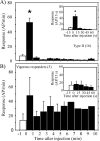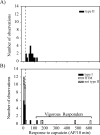Capsaicin responses in heat-sensitive and heat-insensitive A-fiber nociceptors
- PMID: 11404433
- PMCID: PMC6762753
- DOI: 10.1523/JNEUROSCI.21-12-04460.2001
Capsaicin responses in heat-sensitive and heat-insensitive A-fiber nociceptors
Abstract
The recently cloned vanilloid receptor (VR1) is postulated to account for heat and capsaicin sensitivity in unmyelinated afferents. We sought to determine whether heat and capsaicin sensitivity also coexist in myelinated nociceptive afferents. Action potential (AP) activity was recorded from single A-fiber nociceptors that innervated the hairy skin in monkey. Before intradermal injection of capsaicin (10 microg/10 microl) into the receptive field, nociceptors were classified as heat-sensitive (threshold, </=53 degrees C, 1 sec) or heat-insensitive afferents and as mechanically sensitive (von Frey threshold, <6 bar) or mechanically insensitive afferents. All heat-sensitive afferents (n = 16) were insensitive to mechanical stimuli but responded to the intradermal injection of capsaicin (69 +/- 7 APs in 10 min). Responsiveness to mechanical stimuli, thermal stimuli, and capsaicin varied in their receptive fields; the majority of receptive field sites (24 of 36) were responsive to only one or two stimulus modalities, whereas only eight sites responded to all three modalities. For most heat-insensitive afferents, the activity induced by the capsaicin injection did not exceed the activity induced by needle insertion alone. However, the largest response to capsaicin (314 +/- 98 APs in 10 min) was observed for five afferents that were insensitive to heat as well as mechanical stimuli and therefore may be classified as cutaneous chemoreceptors. These results suggest that A-fiber nociceptors play a role in the pain and hyperalgesia associated with capsaicin injection. Our finding that a subgroup of capsaicin-sensitive A-fiber nociceptors are insensitive to heat predicts the existence of heat-insensitive capsaicin receptors.
Figures









Similar articles
-
Myelinated mechanically insensitive afferents from monkey hairy skin: heat-response properties.J Neurophysiol. 1998 Sep;80(3):1082-93. doi: 10.1152/jn.1998.80.3.1082. J Neurophysiol. 1998. PMID: 9744923
-
Neurogenic hyperalgesia: the search for the primary cutaneous afferent fibers that contribute to capsaicin-induced pain and hyperalgesia.J Neurophysiol. 1991 Jul;66(1):212-27. doi: 10.1152/jn.1991.66.1.212. J Neurophysiol. 1991. PMID: 1919668
-
Chemosensitivity and sensitization of nociceptive afferents that innervate the hairy skin of monkey.J Neurophysiol. 1993 Apr;69(4):1071-81. doi: 10.1152/jn.1993.69.4.1071. J Neurophysiol. 1993. PMID: 8492149
-
Abeta-fiber nociceptive primary afferent neurons: a review of incidence and properties in relation to other afferent A-fiber neurons in mammals.Brain Res Brain Res Rev. 2004 Oct;46(2):131-45. doi: 10.1016/j.brainresrev.2004.07.015. Brain Res Brain Res Rev. 2004. PMID: 15464202 Review.
-
Peripheral and central mechanisms of cutaneous hyperalgesia.Prog Neurobiol. 1992;38(4):397-421. doi: 10.1016/0301-0082(92)90027-c. Prog Neurobiol. 1992. PMID: 1574584 Review.
Cited by
-
Selective inflammatory pain insensitivity in the African naked mole-rat (Heterocephalus glaber).PLoS Biol. 2008 Jan;6(1):e13. doi: 10.1371/journal.pbio.0060013. PLoS Biol. 2008. PMID: 18232734 Free PMC article.
-
Sensory defunctionalization induced by 8% topical capsaicin treatment in a model of ultraviolet-B-induced cutaneous hyperalgesia.Exp Brain Res. 2021 Sep;239(9):2873-2886. doi: 10.1007/s00221-021-06170-0. Epub 2021 Jul 24. Exp Brain Res. 2021. PMID: 34302514
-
TRP vanilloid 2 knock-out mice are susceptible to perinatal lethality but display normal thermal and mechanical nociception.J Neurosci. 2011 Aug 10;31(32):11425-36. doi: 10.1523/JNEUROSCI.1384-09.2011. J Neurosci. 2011. PMID: 21832173 Free PMC article.
-
Distinct subclassification of DRG neurons innervating the distal colon and glans penis/distal urethra based on the electrophysiological current signature.J Neurophysiol. 2014 Sep 15;112(6):1392-408. doi: 10.1152/jn.00560.2013. Epub 2014 May 28. J Neurophysiol. 2014. PMID: 24872531 Free PMC article.
-
Polymorphisms in the GTP cyclohydrolase gene (GCH1) are associated with ratings of capsaicin pain.Pain. 2009 Jan;141(1-2):114-8. doi: 10.1016/j.pain.2008.10.023. Epub 2008 Dec 9. Pain. 2009. PMID: 19081190 Free PMC article. Clinical Trial.
References
-
- Ali Z, Meyer RA, Campbell JN. Secondary hyperalgesia to mechanical but not heat stimuli following a capsaicin injection in hairy skin. Pain. 1996;68:401–411. - PubMed
-
- Baumann TK, Simone DA, Shain CN, LaMotte RH. Neurogenic hyperalgesia: the search for the primary cutaneous afferent fibers that contribute to capsaicin-induced pain and hyperalgesia. J Neurophysiol. 1991;66:212–227. - PubMed
-
- Beydoun A, Dyke DBS, Morrow TJ, Casey KL. Topical capsaicin selectively attenuates heat pain and A δ fiber-mediated laser-evoked potentials. Pain. 1996;65:189–196. - PubMed
-
- Campbell JN, LaMotte RH. Latency to detection of first pain. Brain Res. 1983;266:203–208. - PubMed
-
- Campbell JN, Meyer RA. Sensitization of unmyelinated nociceptive afferents in the monkey varies with skin type. J Neurophysiol. 1983;49:98–110. - PubMed
Publication types
MeSH terms
Substances
Grants and funding
LinkOut - more resources
Full Text Sources
Miscellaneous
